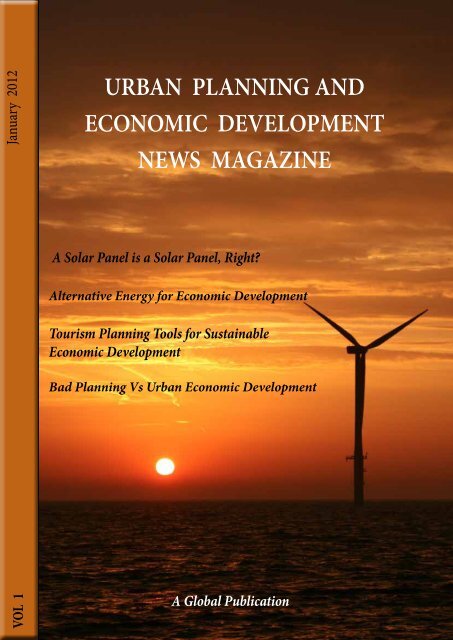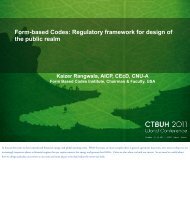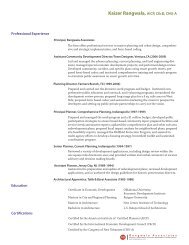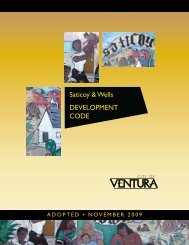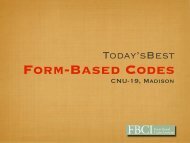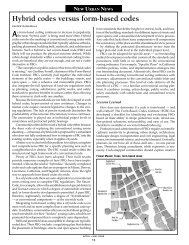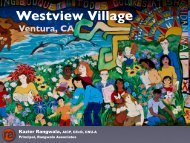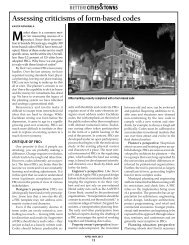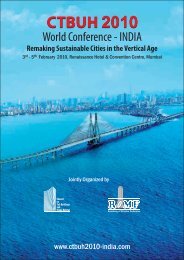urban planning and economic development news magazine
urban planning and economic development news magazine
urban planning and economic development news magazine
Create successful ePaper yourself
Turn your PDF publications into a flip-book with our unique Google optimized e-Paper software.
January 2012<br />
URBAN PLANNING AND<br />
ECONOMIC DEVELOPMENT<br />
NEWS MAGAZINE<br />
A Solar Panel is a Solar Panel, Right<br />
Alternative Energy for Economic Development<br />
Tourism Planning Tools for Sustainable<br />
Economic Development<br />
Bad Planning Vs Urban Economic Development<br />
VOL 1<br />
A Global Publication
Restorative Development Regulations<br />
By Kaizer Rangwala, AICP, CEcD, CNU-A<br />
Restorative Development<br />
Regulations<br />
Sustainability is a low st<strong>and</strong>ard. Storm Cunningham<br />
in his book ReWealth says we should restore. He explains<br />
this with an example: if you ask someone about<br />
their marriage <strong>and</strong> they tell you it is “sustainable” --<br />
you are likely to feel sorry for the person. Instead, if<br />
the answer were the marriage is restoring <strong>and</strong> revitalizing<br />
daily -- that is a step in the right direction. i<br />
Sustainability is a start, but we have a long way ahead if<br />
we are going the restore the human habitat. The good<br />
<strong>news</strong> is that restoring places will create meaningful<br />
jobs, revenues for public sector, healthy economy <strong>and</strong><br />
sense of civilized purpose. Conscientious corporations<br />
<strong>and</strong> government at all levels are interested in<br />
incorporating the latest green <strong>and</strong> sustainable innovation.<br />
Cities <strong>and</strong> counties are looking to incorporate<br />
sustainability features in their <strong>development</strong> are leaning<br />
on technological innovation. Steve Mouzon calls<br />
this “gizmo green” which is an attempt to green at the<br />
edges where they are most visible, without making<br />
adjustments to the core structural inefficiencies. ii<br />
The focus of this article is to discuss the seldom<br />
talked about but inherent restorative <strong>and</strong> conservation<br />
benefits of contextual <strong>urban</strong>ism <strong>and</strong> the regulatory<br />
framework needed to deliver <strong>urban</strong>ism.<br />
Linear vs Looped<br />
The Industrial revolution was a major turning point<br />
in our connection with nature. The efficient assembly<br />
line system flowed energy <strong>and</strong> resources through<br />
the <strong>urban</strong> system with less regard for their origin <strong>and</strong><br />
even lesser regard for the destination of the wastes.<br />
Fossils <strong>and</strong> raw materials are extracted, processed<br />
into consumer products <strong>and</strong> the wastes <strong>and</strong> gases are<br />
discharged into l<strong>and</strong>fill <strong>and</strong> the atmosphere, where it<br />
can no longer be reused. This linear system consumes<br />
more resources <strong>and</strong> produces waste <strong>and</strong> pollution at<br />
much higher rates. The linear machine aesthetic has<br />
also affected our buildings <strong>and</strong> cities.<br />
We have overbuilt <strong>and</strong> strip mined the arable l<strong>and</strong><br />
with sprawling subdivisions, office parks, commercial<br />
strips, <strong>and</strong> shopping malls. In the wake of fiscal, climate,<br />
<strong>and</strong> energy crises, none of these <strong>development</strong><br />
patterns are doing well. Much of what we have built<br />
cannot be sustained or recycled -- their future at best<br />
is suspect. The current <strong>development</strong> pattern is not viable<br />
because it has created misallocation of resources,<br />
inequities, <strong>and</strong> an uncaring populace that is destroying<br />
the very nature that makes our existence possible.<br />
The sprawling single use subdivisions, zoning separation,<br />
<strong>and</strong> professional specializations have fragmented<br />
the complex interrelated aspects of <strong>urban</strong>ism. The<br />
different parts of <strong>urban</strong>ism that worked together in<br />
harmony, when separated have begun to fail in dissonance.<br />
The Modernists stripped architectural details<br />
that were intended to provide human interest <strong>and</strong><br />
scale to our buildings. The International Style freed<br />
the buildings from local design <strong>and</strong> building traditions.<br />
Our inability to design neighborhoods <strong>and</strong><br />
buildings that can relate with humans <strong>and</strong> nature has<br />
resulted in a public mistrust towards any growth.<br />
Nature operates in a circular closed-looped metabolism,<br />
where there is no waste. Every output is also an<br />
input which replenishes the whole system. The circular<br />
metabolism reduces consumption <strong>and</strong> pollution<br />
encourages recycling <strong>and</strong> maximizes renewables. To<br />
meet the growing needs of an increasingly <strong>urban</strong> <strong>and</strong><br />
developed world, we will need to study the ecology of<br />
natural systems <strong>and</strong> evolve from the linear to a circular<br />
metabolic system in our <strong>planning</strong>, coding, <strong>and</strong><br />
building efforts. Our economy, cities, <strong>and</strong> buildings<br />
will need to shift from consumption to conservation<br />
where we make fewer resources last longer.<br />
Urbanism<br />
At 49%, buildings consume a large percentage of energy<br />
<strong>and</strong> are responsible for 47% of carbon emissions.<br />
The transportation sector consumes 28% of energy<br />
<strong>and</strong> emits 33% of carbon emissions. iii Efficient buildings<br />
within compact, diverse, <strong>and</strong> connected communities<br />
encourage walking, biking <strong>and</strong> transit use, reducing<br />
energy consumption, trips <strong>and</strong> air pollution.<br />
34
Restorative Development Regulations<br />
By Kaizer Rangwala, AICP, CEcD, CNU-A<br />
People who live in walkable communities are more<br />
physically active <strong>and</strong> healthy. They live in smaller<br />
spaces because the outdoor public realm is rich. They<br />
also consume less <strong>and</strong> produce less trash. Urbanism<br />
creates identity <strong>and</strong> preserves natural resources.<br />
A UC Berkeley report by Joanna Malaczynski concludes<br />
that <strong>urban</strong>ism in Central Hercules over the<br />
next 30 year period will reduce daily VMT by 25 miles<br />
saving consumers nearly half a billion dollars in gasoline.<br />
iv Peter Calthorpe in his book Urbanism <strong>and</strong> Climate<br />
Change compares a 30% energy savings from a<br />
green home in sprawl to a townhome in a village that<br />
will conserve 58% less energy <strong>and</strong> a condo in the city<br />
will save 73% energy savings. “Traditional <strong>urban</strong>ism,<br />
even without green technology, is better than green<br />
sprawl,” says Calthorpe. v<br />
Development regulations need to be reexamined for<br />
their contributions to VMT <strong>and</strong> greenhouse gases.<br />
Particularly, the old zoning <strong>and</strong> subdivision tools<br />
created in response to a linear, consumption driven<br />
industrialized society will need to be replaced with a<br />
comprehensive framework that will balance the timetested<br />
principles of <strong>urban</strong>ism with the conservation<br />
technological innovations. Simply tagging on high<br />
performance buildings <strong>and</strong> infrastructure st<strong>and</strong>ards<br />
to a conventional zoning <strong>and</strong> subdivision platform<br />
misses out on the larger benefits of having a diverse<br />
population engaged in diverse activities within a walkable<br />
<strong>and</strong> human scaled public environment shaped by<br />
buildings, streets <strong>and</strong> open spaces.<br />
Why Form-Based Codes (FBCs)<br />
FBCs offer a comprehensive <strong>and</strong> integrated framework<br />
that combines the individual elements of <strong>urban</strong>ism<br />
— the buildings, streets, <strong>and</strong> open space — into<br />
a cohesive <strong>and</strong> memorable place. The full spectrum<br />
of l<strong>and</strong>-use st<strong>and</strong>ards such as <strong>planning</strong>, zoning, subdivision,<br />
public works, <strong>and</strong> safety st<strong>and</strong>ards operate<br />
in unison, rather than allowing these systems to clash<br />
with one another. FBCs operate at different locations,<br />
scales <strong>and</strong> intensities of <strong>urban</strong>ism, allowing a seamless<br />
framework to integrate transportation choices<br />
that will reduce trips <strong>and</strong> preserve the region’s environment.<br />
The conventional zoning codes proscribe <strong>development</strong><br />
st<strong>and</strong>ards. There is no lack of effort in calling<br />
out all the things that the codes should not allow.<br />
What conventional zoning codes fail to do is to prescribe<br />
what should be allowed. Because the st<strong>and</strong>ards<br />
are abstract <strong>and</strong> vague they fail to conceptualize <strong>and</strong><br />
inspire the sum of individual projects to add up to a<br />
desirable place.<br />
On the other h<strong>and</strong>, sustainability like form-based<br />
codes is based on a specific vision of the local place.<br />
FBCs begin by obsessively observing the place: what<br />
works <strong>and</strong> what feels right for the climate zone, regionally<br />
available materials, construction techniques,<br />
local culture, <strong>and</strong> traditions. Traditional building designs<br />
are durable <strong>and</strong> they age well -- usually conserve<br />
energy because they show respect to sun, wind, <strong>and</strong><br />
local climate. Simple traditional building design features<br />
such as party wall separation, well-positioned<br />
<strong>and</strong> operable windows <strong>and</strong> high ceilings offer better<br />
solar, lighting <strong>and</strong> ventilation than solar cells, energyefficient<br />
bulbs or air conditioning devices. The time<br />
tested preferences of traditional architecture combined<br />
with <strong>urban</strong>ism increase our chances of conserving<br />
energy, materials, <strong>and</strong> money <strong>and</strong> consistently<br />
delivers what Mouzon calls “lovable places.”<br />
Flagstaff, AZ, the rural to <strong>urban</strong> transect provides a<br />
regional framework to contextually incorporate high<br />
performance building <strong>and</strong> infrastructure solutions<br />
within a range of settlement types. The solar access<br />
overlay on the regulating plan examines <strong>and</strong> adopts a<br />
palette of appropriate approaches to harness solar energy.<br />
Hydrology is calibrated to the different areas of<br />
the transect: surface infiltration with vegetative swales<br />
in T1-T3 <strong>and</strong> subsurface <strong>urban</strong> channels in T4-T6.<br />
Rainwater harvesting <strong>and</strong> wastewater is collected in<br />
rain barrels in T2, T3 <strong>and</strong> cisterns in T3 to T6.<br />
Restore with Nature<br />
If a marriage is not sustainable, divorce is an option.<br />
Our fate cannot be separated from this planet. We<br />
have to make the difficult choices <strong>and</strong> repair our bond<br />
with nature. Our affair with the resource <strong>and</strong> pollu-<br />
35
Restorative Development Regulations<br />
By Kaizer Rangwala, AICP, CEcD, CNU-A<br />
tion heavy linear based society must end. As stewards<br />
of the built <strong>and</strong> natural environments, planners<br />
must be the first to require resources to operate within<br />
a closed loop system.<br />
Given good information <strong>and</strong> a choice, most communities<br />
embrace <strong>urban</strong>ism which is inherently sustainable.<br />
And such design will decrease VMT <strong>and</strong> CO2<br />
emissions <strong>and</strong> increase individual physical activity<br />
<strong>and</strong> health. FBCs regulate high quality walkable <strong>urban</strong>ism<br />
but are also an inherently effective way to integrate<br />
sustainability features based on type <strong>and</strong> character<br />
of the community. Form-Based Codes (FBCs)<br />
produce high quality compact, mixed-use, <strong>and</strong> walkable<br />
<strong>urban</strong>ism that use less resources <strong>and</strong> generates<br />
fewer VMT <strong>and</strong> greenhouse gases.<br />
i Cunningham Storm, ReWealth: Stake Your Claim in<br />
the $2 Trillion Development Trend That’s Renewing<br />
the World, McGraw-Hill, 2008.<br />
ii Mouzon Stephen, The Original Green, UNlocking<br />
the Mystery of True Sustainability, The Guild Foundation<br />
Press, Miami, 2010.<br />
iii Architecture 2030, www.architecture2030.org.<br />
iv Parolek Dan, et al, FBCI Webinar on Integrating<br />
More Sustainable Design Into Fom-Based Codes.<br />
v<br />
Calthorpe Peter, Urbanism in the Age of Climate,<br />
Isl<strong>and</strong> Press, 2010.<br />
36


